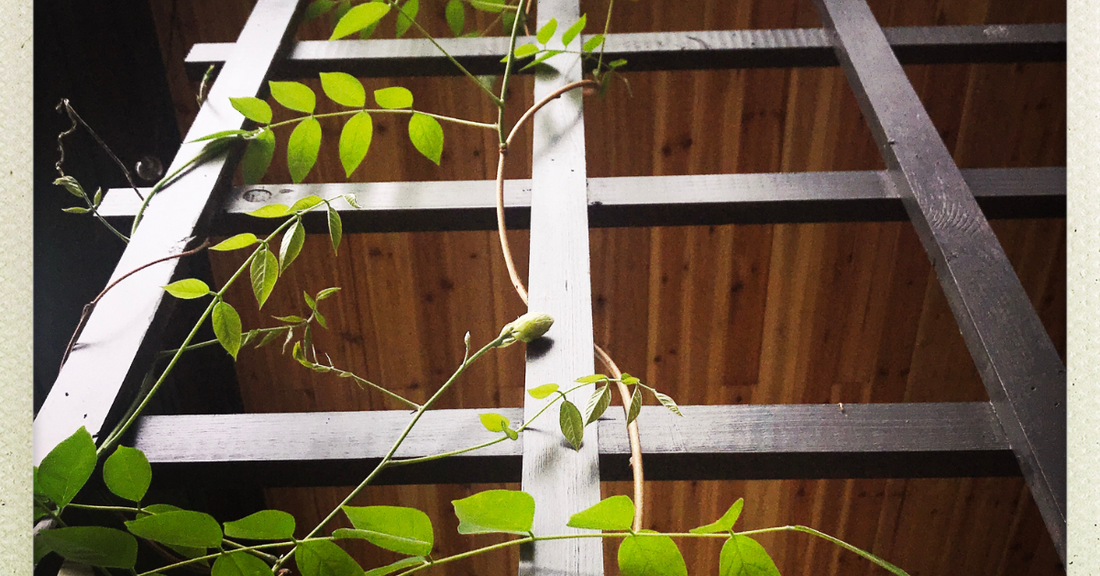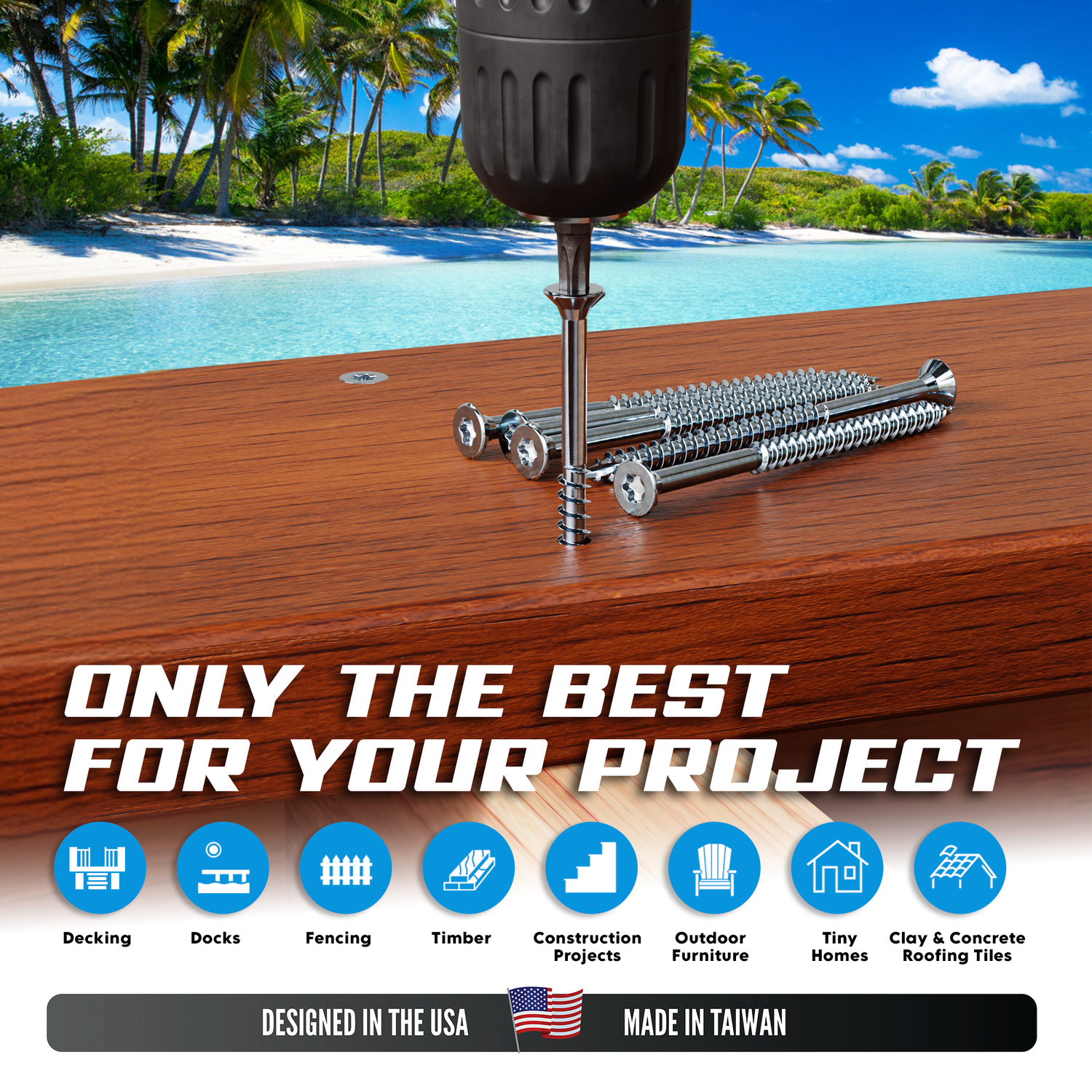
Cheap DIY Wood Trellis Designs Using Stainless Steel Screws
Share
A simple timber structure is the cheapest way to make your own wooden garden trellis. You don’t need a fancy shop to build a wood trellis that works. The goal is simple: give your cucumbers, peas, tomatoes, roses, and other climbers a sturdy place to grow, add vertical space to small beds, and keep the cost down.
We're timber construction professionals, and we'll share with you the cheap DIY wood trellis plans we experts approve. And although gardening is making do with what you have, not all “DIY hacks” can save you money (and some might even harm your plants).
We’ll point to low‑cost materials, the handful of tools you really need, and which (sturdy and safe) design fits your plants, whether you’re planting heavy watermelons or light peas.
What to Consider Before Building A DIY Wooden Trellis That’s Best for Your Garden
Before we get into the DIY wood trellis plans, start with one question: “Which trellis is best for my garden?” Answer these before you build your wood trellis.
What Kind Of Wood Should I Use For A Trellis?
The kind of wood you use for your wood trellis should be naturally rot-resistant types of wood. You can use cedar, black cherry, oak (bur, chestnut, post, or white), black locust, Osage orange, or redwood. These woods contain natural oils and compounds that slow down the decay process.
You can also use pressure-treated wood. Many gardeners still believe that pressure-treated wood today can leach harmful chemicals into the soil, but that’s no longer true.
Arsenic-based PT hasn’t been used for most residential projects in the US and Canada for 20 years, but old pieces are still out there. If you’re pulling boards from old decks, fences, or sleepers built before 2004 to build your wood trellis, assume they’re CCA-treated.
What Screws To Use For Trellis?
If you’re thinking staples are cheaper and less visible than deck screws, you’re right on price and profile, but not on strength. For a trellis that actually lasts, just use screws.

Always use stainless steel deck screws for your DIY wood trellis. They don’t rust or seize, so your joints stay tight in rain, sun, and salt air.
As for the sizes, for ¾″ stock (fence-picket builds), go for #8 or #9 screws, 1⅝″–2″, and for 2x stock, use #10–#12, 3″–3½″.
Pro Tip: Pilot holes are a must, especially in thin pieces. If you’re repurposing crates, which are usually softwoods like pine/SPF, to build a wood trellis, you’ll end up with skinny slats. Driving screws near the ends of those thin pieces is likely to split them unless you pre‑drill. Do this:
-
- Drill a clearance hole in the first board (about the thread diameter) so the screw slides through.
- Drill a pilot hole in the second board (about the core/shank diameter) so the threads bite without wedging the wood apart.
Set up this way, the screw pulls the boards together and keeps them from cracking.
How To Anchor A Wooden Trellis For All Types Of Plants?
If you’re training light climbers or hauling up heavy fruit, build to match what you’re growing. Weight matters, but wind is the real bully. Foliage turns a trellis into a sail. A gusty afternoon or a garden-variety thunderstorm can flip a frame that’s just leaning. Anchor it to something solid; smart anchoring beats oversized lumber every time.
Light Climbers: Peas (snow & snap), pole beans, sweet peas, morning glory, black‑eyed Susan vine, climbing nasturtium, and lots of clematis.
- Frame: simple 1×2 or 1×3 with skinny slats (⅜″–¾″ thick, 1–2″ wide).
- Posts/anchors: 2×2 stakes or screw the frame to a raised‑bed rim; set 12–18″ deep or use ground spikes.
- Bracing & screws: one small diagonal if you like; stainless #8–#9 screws (1⅝″–2″) and pre‑drill near ends.
Medium Climbers: cucumbers have more mass than peas/beans but nowhere near melons, so treat them as medium.
- Frame: 2×2 or 1×3 perimeter with sturdier cross rails; aim for 5–7 ft tall.
- Posts/anchors: at least two posts, 18–24″ deep, or metal post bases; add one diagonal brace per panel.
- Hardware: stainless #10 deck screws (2½″–3″). Let rails sit on posts so wood carries the load; screws just clamp.
Heavy Fruiters: Cantaloupe/honeydew, icebox watermelons, winter squash (butternut, acorn), small pumpkins, and also high‑mass vines like hops.
- Frame: beefier 2×3 or 2×4 rails with a wire/grid panel or tight slat spacing.
- Posts/anchors: 4×4 posts set 24–36″ deep (use concrete in windy/coastal spots) or bolt to a fence/house. Two anchor points beat one.
- Bracing & joints: a full X‑brace or tensioned wire; use through‑bolts or ¼″–5⁄16″ lags at main joints.
- Fruit support: add soft fabric/mesh slings under developing fruit. Skip twine; it stretches and fails.
Wind rule: a light 1×2 frame can carry a melon vine if it’s anchored well; a bulky frame will still blow over if it’s just leaning. Fasten to something permanent, like posts set like fenceposts or the side of a garage/house.
Winter: leave your wood trellises out or stash them in the garage; either works. Dry storage just slows the wear.
DIY Wood Trellis Plans You Can Easily and Cheaply Build
After years of building wooden structures, we’ve learned that the real cost is your time and effort. Save fifty bucks today, and you might be rebuilding in a couple of years. Nobody wants that. Here’s how to build a wood trellis easily and cheaply, and it's expert-approved:
Trellis #1: Folding A-Frame
This folding A-frame wood trellis works beautifully for peas, pole beans, cucumbers, and small melons. It stands directly over your garden bed during the growing season and folds flat for easy winter storage when you are done harvesting.

Lumber & Hardware
- 2x2 redwood or cedar
- Two or three exterior hinges
- #8 stainless steel wood screws
Cut list
- Cut 4 pieces, each 48 inches long, for side rails: two per panel
- Cut 10 pieces, each 45 inches long, for slats; five per panel
- Cut 2 spacer blocks at 10 1/8 inches for even gaps
Steps:
- Assemble the first panel: Lay two 48-inch rails on a flat surface. Position a 45-inch slat at the very top and another at the bottom. Add a light bead of exterior glue, square it, then drive two 1⅝-inch stainless screws at each joint.
- Fill in the slats: Use the 10⅛-inch spacers to keep gaps consistent. Secure each slat with two 1⅝-inch stainless screws at both ends.
- Repeat for the second panel.
- Add hinges: Stand the panels like an A and install two or three exterior hinges along the top edge with stainless screws. Check that it folds flat.
- Set in the bed: Open the frame over your row and push the feet a couple inches into the soil. For a fixed spread, add a short chain between the lower legs.
Trellis #2: Post-and-Wire
This post-and-wire wood trellis is a fast, sturdy solution for peas, cucumbers, and flowering vines, and it works well in both raised beds and in-ground gardens.

Lumber & Hardware
- One 4x4 post, cut into two posts 48 inches long
- Welded wire or hardware cloth
- Heavy-duty stainless staples (or screw-in wire clamps)
- 2 ½- to 3-inch stainless steel screws
Steps
- Cut and dress the posts: Cut two posts, each 48 inches long. For a clean top, mark ¾ inch around and cut a 45-degree chamfer.
- Set the posts: In a raised bed, sink the posts a few inches and screw them to the bed wall with 2½- to 3-inch stainless steel screws. In the ground, dig holes, set the posts, and tamp firmly.
- Attach the wire: Cut welded wire to span between the posts. Pull it taut and staple every few inches with stainless staples (or use wire clamps and short stainless screws).
Trellis #3: Wood Obelisk Trellis
A space-saving vertical wood trellis that fits neatly in small beds. It handles peas and cucumbers, and with modest reinforcement plus fruit slings, it can support small melons such as cantaloupe or charentais (about 1-3 lb) and personal watermelons (about 3-6 lb). For larger watermelons or pumpkins, choose a heavier-duty design.

Lumber & Hardware
- 5/4 cedar decking (three 8-ft boards) for legs, rails, and cap
-
Stainless steel wood screws:
- #8 × 1-1/4"–1-3/8" (rails & lattice into 1" legs)
- #8 × 1-1/2" (top cap into legs)
- Optional: a handful of #10 × 1-1/2" at fruiting tiers for extra strength
- Exterior wood glue (for the top cap panel)
- 4 ground stakes (12–18") or screw-in anchors
- Sling material for fruit (produce netting, nylon webbing, or old T-shirts)
Cut list
- Legs: 4 pieces at 1" × 1" × 66"
-
Rails: 20 pieces at 1/2" thick × 1-1/2" wide, lengths cut-to-fit in the jig (expect ~14" at the bottom tier tapering to ~8" near the top)
Tip: Plan for 5 tiers (4 rails per tier, one on each face) - Vertical lattice (accent strips): 16–20 pieces at 1/2" × 1/2", lengths cut-to-fit
- Top cap: Edge-glue a panel and cut to 8" × 8" (round over top edges)
- Template (jig): 1 plywood base 18" × 36" + two straight fence strips set to your chosen leg angle
Steps
- Build the angle template: Screw two straight fences to a plywood base to cradle a pair of legs at your desired inward lean. Add a bottom stop so leg tips register consistently.
- Prep legs & layout: Rip and sand the legs to 1" × 1". Tape the four legs together into a bundle and mark three guides on all faces: a bottom line for each rail tier, a bevel line that keeps the rails level when the legs are set at an angle, and a 1/4" reveal from the leg edges for clean, consistent alignment.
- Assemble the first panel: Drop two legs in the template. Cut the first set of rails to fit. Pre-drill and countersink; fasten each rail with two #8 × 1-1/4"–1-3/8" stainless screws per end aligned to your bevel and reveal marks.
- Assemble the second panel: Repeat Step 3 for the opposite pair of legs.
- Join the panels: Stand both panels in/against the template and bridge them with rails at each tier. Pre-drill and secure as above.
- Reinforce for melons: At one mid-height tier on each face, either double up the rail (sister a second rail behind it) or use #10 screws for that tier. Add one short diagonal brace per face at a mid-tier to reduce racking.
- Add vertical lattice: Install 1/2" × 1/2" strips between tiers for climbing support, fastening with #8 × 1-1/4" stainless (or #6 × 1") and pre-drilling to prevent splits.
- Make and mount the top cap: Glue up decking, cut to 8" × 8", round over edges, then drive #8 × 1-1/2" stainless down into each leg (plug or fill if desired).
- Anchor in the bed: Set the obelisk where it will live. Drive 12–18" stakes just inside each leg and secure the legs to stakes with stainless screws, or use screw-in ground anchors.
- Sling the fruit: As melons set, add slings so each fruit’s weight transfers across two rails/legs, not just one. Inspect after heavy rain/wind.
Load limits: This wood obelisk trellis works great with small melons when you use slings. It is not suited to 10 to 20+ lb watermelons or pumpkins. If you want to grow heavier fruit, step up to 1 1/2-inch legs, 3/4 inch rails, and #10 stainless screws, and add a carriage bolt at each tier.
The Best Garden Trellis Is Built with The Best Stainless Steel Screws
The best trellises start with the best stainless steel screws, and we build ours that way. Our screws use a star or Torx drive that keeps the bit locked in, reduces cam-out, and transfers torque better into dense hardwoods. A low-friction coating can cut driving torque by up to 20 percent, so your drill and bits last longer and starts are easier. They are solid stainless, so they resist rust in heat, rain, and freeze-thaw.
Build your DIY wood trellis with our DIY Pack. You get 400 304 stainless steel screws in four sizes: #8 x 1-5/8", #10 x 2", #10 x 2.5", and #10 x 3", plus matching Torx drivers for each size. Your all-in-one stainless screw kit for indoor and outdoor builds, reliable and corrosion-resistant on every project.
Want to know why pros continue to trust our screws for every timber construction project they take on? Try a free sample and feel the difference for yourself today!
FAQs
How tall should your trellis be?
Your trellis should be 4 to 5 feet tall, which is the standard for easy pruning, pollination, and wind stability. That is the rule of thumb we follow because anything taller becomes hard to manage and more likely to blow over. From there, let the crop and the trellis angle guide you. If the structure is vertical, you will work a little lower than if it is set on an angle.
Choose based on how much you want to prune and water, how windy your site is, and how high you can comfortably reach. There is no single right answer here, just solid starting points you can adjust for your space and your height.
How to protect a wooden trellis?
Protect your wooden trellis by choosing a finish that fits your climate and the look you want. For maximum weather resistance, use an exterior wood preservative or a quality exterior paint to guard against moisture and UV.
If you prefer a natural look, pure linseed or pure tung oil are good options; they age gracefully but need periodic recoating, and their performance depends on local conditions.


